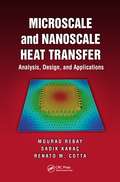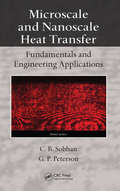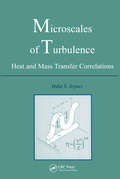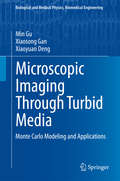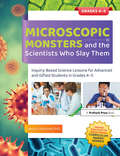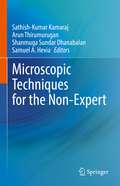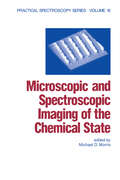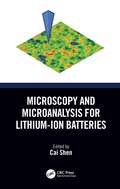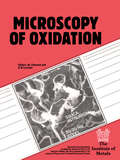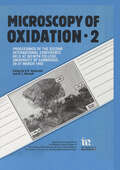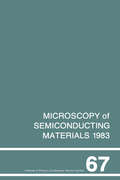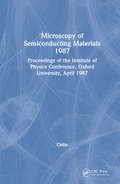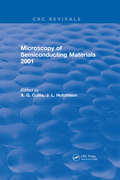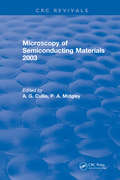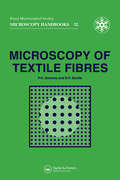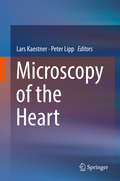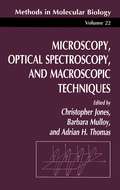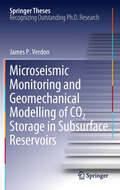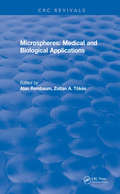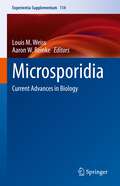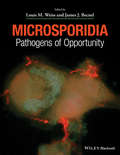- Table View
- List View
Microscale and Nanoscale Heat Transfer: Analysis, Design, and Application
by Renato M. Cotta Sadik Kakaç Mourad RebayMicroscale and Nanoscale Heat Transfer: Analysis, Design, and Applications features contributions from prominent researchers in the field of micro- and nanoscale heat transfer and associated technologies and offers a complete understanding of thermal transport in nano-materials and devices. Nanofluids can be used as working fluids in thermal system
Microscale and Nanoscale Heat Transfer: Fundamentals and Engineering Applications
by C.B. Sobhan G.P. PetersonThrough analyses, experimental results, and worked-out numerical examples, Microscale and Nanoscale Heat Transfer: Fundamentals and Engineering Applications explores the methods and observations of thermophysical phenomena in size-affected domains. Compiling the most relevant findings from the literature, along with results from their own re
Microscales of Turbulence
by Vedat S ArpaciThis monograph presents the microscales of complex (buoyant, thermocapillary, two-phase, reacting, radiating, pulsating, etc.) turbulent flows and interprets heat and mass transfer correlations in terms of these scales. The author introduces a general methodology for the development of microscales for complex turbulent flows. Then he provides, by these scales, a fundamental interpretation for a number of momentum, heat, and mass transfer correlations which are assumed to be empirical. Lastly, he develops correlations in terms of these scales for environmentally and/or technologically important problems related to buoyancy driven flows, pulsating flows, diffusion flows, fires, etc.
Microscopic Dynamics of Plasmas and Chaos (Series in Plasma Physics)
by Y ElskensMicroscopic Dynamics of Plasmas and Chaos discusses the resonant wave-particle interaction in plasmas, provides the tools for chaotic Hamiltonian dynamics, and describes a turbulent macroscopic system through the chaotic classical mechanics of the corresponding N-body problem. The book begins with the fundamentals of N-body dynamics, followed by a
Microscopic Foundations of Relativistic Fluid Dynamics (Lecture Notes in Physics #990)
by Gabriel S. Denicol Dirk H. RischkeThis book provides an introduction to relativistic dissipative fluid dynamics, with particular emphasis on its derivation from microscopic transport theory. After a phenomenological derivation of relativistic dissipative fluid dynamics from the second law of thermodynamics, the intrinsic instabilities of relativistic Navier-Stokes theory are discussed. In turn, analytical solutions of relativistic dissipative fluid dynamics are presented. Following, the authors discuss several theories and approaches to derive transport coefficients in dissipative fluid dynamics such as the Chapman-Enskog theory, the theory of Israel and Stewart, and a more recent derivation of relativistic dissipative fluid dynamics based on kinetic theory, which constitutes the main focus of the second part of this book. This book is intended for advanced graduate students and researchers in physics and requires basic knowledge of the theory of special and general relativity. It should be of particular interest to researchers that apply relativistic fluid dynamics in cosmology, astrophysics, and high-energy nuclear physics.
Microscopic Imaging Through Turbid Media
by Min Gu Xiaosong Gan Xiaoyuan DengThis book provides a systematic introduction to the principles of microscopic imaging through tissue-like turbid media in terms of Monte-Carlo simulation. It describes various gating mechanisms based on the physical differences between the un scattered and scattered photons and method for microscopic image reconstruction, using the concept of the effective point spread function. Imaging an object embedded in a turbid medium is a challenging problem in physics as well as in bio photonics. A turbid medium surrounding an object under inspection causes multiple scattering, which degrades the contrast, resolution and signal-to-noise ratio. Biological tissues are typically turbid media. Microscopic imaging through a tissue-like turbid medium can provide higher resolution than transillumination imaging in which no objective is used. This book serves as a valuable reference for engineers and scientists working on microscopy of tissue turbid media.
Microscopic Monsters and the Scientists Who Slay Them: Inquiry-Based Science Lessons for Advanced and Gifted Students in Grades 4-5
by Jason S. McIntoshRecipient of the 2019 NAGC Curriculum Award It is a germy world out there, and students are naturally curious about this hidden world. Microscopic Monsters and the Scientists Who Slay Them, a 30-lesson interdisciplinary science unit: Is designed to teach high-ability fourth and fifth graders how to think like real-world epidemiologists. Was designed using the research-based Integrated Curriculum Model. Features challenging problem-based learning tasks and engaging resources. Includes detailed teacher instructions and suggestions for differentiation. Is winner of the National Association for Gifted Children's curriculum award. In unit, students apply principles of epidemiology and microbiology to respond to a fictional epidemic and its effect on their town, all while building an understanding of the perseverance required to detect, track, and stop epidemics through the experiences of real-life epidemiologists and exploring career paths available in the diverse fields of medicine and microbiology. Suggestions and guidance are included on how teachers can adjust the rigor of learning tasks based on students' interests and needs. Grades 4-5
Microscopic Techniques for the Non-Expert
by Sathish-Kumar Kamaraj Arun Thirumurugan Shanmuga Sundar Dhanabalan Samuel A. HeviaThis book covers fundamental microscopic techniques for Scanning Electron Microscopy (SEM), Transmission Electron Microscopy (TEM), Atomic Force Microscopy (AFM), and other microscopic tools. It provides step-by-step instructions and explanations of the basic fundamental concepts and mechanisms and guides the reader on resolving queries related to taking and analyzing microscopy images. The latest advancements and developments in microscopic equipment are described. Theoretical background on microscopy is also provided to enhance the reader’s understanding of microscopy techniques and tools. Microscopic Techniques for the Non-Expert is an ideal book for undergraduate and postgraduate students, as well as researchers with a background in environmental science, materials science, biomedicine, engineering, or bio-nanotechnology.
Microscopic and Spectroscopic Imaging of the Chemical State
by Michael D. MorrisPresents chemical state imaging methods useful on distance scales ranging from individual atoms to millimeters. This work is intended for chemists familiar with modern spectroscopies, but includes tutorial material on basic imaging processes for those with little background in the field.
Microscopy Techniques for Biomedical Education and Healthcare Practice: Principles in Light, Fluorescence, Super-Resolution and Digital Microscopy, and Medical Imaging (Biomedical Visualization #2)
by Leonard ShapiroThis edited book has a strong focus on advances in microscopy that straddles research, medical education and clinical practice. These advances include the shift in power from conventional to digital microscopy. The first section of this book covers imaging techniques and morphometric image analysis with its applications in biomedicine using different microscopy modes. Chapters highlight the rich development of fluorescence methods and technologies; particle tracking techniques with applications in biomedical research and nanomedicine; the way in which visualizations have revolutionized taxonomy from gross anatomy to genetics; and the psychology of perception and how it affects our understanding of cells and tissues. The book’s first section concludes by exploring the use of CT modalities to evaluate anterior deformities in craniosynostosis. In the second section of the book, chapters on anatomical and cell biology education explore the history of anatomical models and their use in educational settings. This includes examples in 3D printing and functional human anatomical models that can be created using easily available resources and the use of biomedical imaging in visuospatial teaching of anatomy; the novel use of ultrasound in medical education and practice; and skill acquisition in histology education using a flowchart called a ‘decision tree’. This book will appeal to histologists, microscopists, cell biologists, clinicians and those involved in anatomical education and biomedical visualization, as well as students in those respective fields.
Microscopy and Microanalysis for Lithium-Ion Batteries
by Cai ShenThe past three decades have witnessed the great success of lithium-ion batteries, especially in the areas of 3C products, electrical vehicles, and smart grid applications. However, further optimization of the energy/power density, coulombic efficiency, cycle life, charge speed, and environmental adaptability are still needed. To address these issues, a thorough understanding of the reaction inside a battery or dynamic evolution of each component is required. Microscopy and Microanalysis for Lithium-Ion Batteries discusses advanced analytical techniques that offer the capability of resolving the structure and chemistry at an atomic resolution to further drive lithium-ion battery research and development. Provides comprehensive techniques that probe the fundamentals of Li-ion batteries Covers the basic principles of the techniques involved as well as its application in battery research Describes details of experimental setups and procedure for successful experiments This reference is aimed at researchers, engineers, and scientists studying lithium-ion batteries including chemical, materials, and electrical engineers, as well as chemists and physicists.
Microscopy of Oxidation
by G.W. LorimerMicroscopy of Oxidation: the proceedings of the Second International Conference Held at Selwyn College, University of Cambridge, in 1991.
Microscopy of Oxidation: Proceedings of the Second International Conference Held at Selwyn College, University of Cambridge, 29-31 March 1993
by S.B. NewcombMicroscopy of Oxidation: the proceedings of the Second International Conference Held at Selwyn College, University of Cambridge, on 29-31 1993.
Microscopy of Semiconducting Materials 1983, Third Oxford Conference on Microscopy of Semiconducting Materials, St Catherines College, March 1983
by A.G. CullisThis volume contains invited and contributed papers at the conference on Microscopy of Semiconducting Materials which took place on 21–23 March 1983 in St Cathernine's College, Oxford. The conference was the third in the series devoted to advances in microscopical studies of semiconductors.
Microscopy of Semiconducting Materials 1987, Proceedings of the Institute of Physics Conference, Oxford University, April 1987
by A.G. CullisThe various forms of microscopy and related microanalytical techniques are making unique contributions to semiconductor research and development that underpin many important areas of microelectronics technology. Microscopy of Semiconducting Materials 1987 highlights the progress that is being made in semiconductor microscopy, primarily in electron probe methods as well as in light optical and ion scattering techniques. The book covers the state of the art, with sections on high resolution microscopy, epitaxial layers, quantum wells and superlattices, bulk gallium arsenide and other compounds, properties of dislocations, device silicon and dielectric structures, silicides and contacts, device testing, x-ray techniques, microanalysis, and advanced scanning microscopy techniques. Contributed by numerous international experts, this volume will be an indispensable guide to recent developments in semiconductor microscopy for all those who work in the field of semiconducting materials and research development.
Microscopy of Semiconducting Materials 2001: Proceedings Of The Royal Microscopical Society Conference, Oxford University, 25-29 March 2001
by A.G. CullisThe Institute of Physics Conference Series is a leading International medium for the rapid publication of proceedings of major conferences and symposia reviewing new developments in physics and related areas. Volumes in the series comprise original refereed papers and are regarded as standard referee works. As such, they are an essential part of major libration collections worldwide.The twelfth conference on the Microscopy of Semiconducting Materials (MSM) was held at the University of Oxford, 25-29 March 2001. MSM conferences focus on recent international advances in semiconductor studies carried out by all forms of microscopy. The event was organized with scientific sponsorship by the Royal Microscopical Society, The Electron Microscopy and Analysis Group of the Institute of Physics and the Materials Research Society. With the continual shrinking of electronic device dimensions and accompanying enhancement in device performance, the understanding of semiconductor microscopic properties at the nanoscale (and even at the atomic scale) is increasingly critical for further progress to be achieved. This conference proceedings provides an overview of the latest instrumentation, analysis techniques and state-of-the-art advances in semiconducting materials science for solid state physicists, chemists, and materials scientists.
Microscopy of Semiconducting Materials 2003
by CullisModern electronic devices rely on ever-greater miniaturization of components, and semiconductor processing is approaching the domain of nanotechnology. Studies of devices in this regime can only be carried out with the most advanced forms of microscopy. Accordingly, Microscopy of Semiconducting Materials focuses on international developments in semiconductor studies carried out by all forms of microscopy. It provides an overview of the latest instrumentation, analysis techniques, and state-of-the-art advances in semiconducting materials science for solid state physicists, chemists, and material scientists.
Microscopy of Semiconducting Materials: 1999 Proceedings of the Institute of Physics Conference held 22-25 March 1999, University of Oxford, UK (Institute of Physics Conference Series)
by A G Cullis R BeanlandWith IC technology continuing to advance, the analysis of very small structures remains critically important. Microscopy of Semiconducting Materials provides an overview of advances in semiconductor studies using microscopy. The book explores the use of transmission and scanning electron microscopy, ultrafine electron probes, and EELS to investigat
Microscopy of Textile Fibres
by P H Greaves B P SavilleAn up-to-date practical guide to the properties and characteristics of textile fibres, with clear advice on sampling, specimen preparation and examination procedures.
Microscopy of the Heart
by Lars Kaestner Peter LippThis book provides in depths information on different microscopy approaches and supplies the reader with methods how to untangle highly complex processes involved in physiological and pathophysiological cardiac signaling. Microscopy approaches have established themselves as the quasi gold standard that enables us to appreciate the underlying mechanisms of physiological and pathophysiological cardiac signaling. This book presents the most important microscopy techniques from the level of individual molecule e.g. Förster-Resonance Energy Transfer (FRET), up to cellular and tissue imaging, e.g. electron microscopy (TEM) or light sheet microscopy. The book is intended for graduate students and postdocs in cardiovascular research, imaging and cell biology, pre-clinical and clinical researchers in cardiovascular sciences as well as decision makers of the pharmaceutical industry.
Microscopy, Optical Spectroscopy, and Macroscopic Techniques
by Adrian H. Thomas Christopher Jones Barbara MulloyThis superb survey of the possible applications of physiochemical techniques to the analysis of biological macromolecules is designed for the practicing biochemist or biologist who wants to use the technique but lacks the experience. The contributors emphasize practical aspects, such as constraints on sample quantity, purity, and presentation; the problems of time and expense involved; the problems a technique is best suited to solve; and how the results may be interpreted. Among the methods examined are optical and infrared spectroscopy, microscopy, ultracentrifugation, calorimetry, X-ray and neutron scattering, and light scattering. This book will enable the reader to confidently collaborate with specialists in applying these techniques.
Microseismic Monitoring and Geomechanical Modelling of CO2 Storage in Subsurface Reservoirs
by James P. VerdonThis thesis presents an impressive summary of the potential to use passive seismic methods to monitor the sequestration of anthropogenic CO2 in geologic reservoirs. It brings together innovative research in two distinct areas - seismology and geomechanics - and involves both data analysis and numerical modelling. The data come from the Weyburn-Midale project, which is currently the largest Carbon Capture and Storage (CCS) project in the world. James Verdon's results show how passive seismic monitoring can be used as an early warning system for fault reactivation and top seal failure, which may lead to the escape of CO2 at the surface.
Microspheres: Medical and Biological Applications (CRC Press Revivals)
by Alan Rembaum Zoltan A. TokesWe have previously described the syntheses of both magnetic and nonmagnetic polymeric microspheres, and we have reported their application in removal of neuroblastoma cells from normal cells in bone marrow, in the separation of red blood cells, and the separation of human B and T lymphocytes. In the present study, we describe a series of hydrophilic microspheres consisting of (1) poly-HEMA and (2) a copolymer sequence of HEMA-acrolein microspheres.
Microsporidia: Current Advances in Biology (Experientia Supplementum #114)
by Louis M. Weiss Aaron W. ReinkeThis book provides an up-to-date overview on the biology of microsporidia, focusing on areas where significant progress has been made in recent years. In particular, our understanding of the evolutionary position and the role of genome reduction in the biology of these enigmatic intracellular pathogens is discussed. This book also offers important updates on the mechanisms used by these organisms to modify the host cell biology of mammals, insects, nematodes, and aquatic animals, as well as the mechanisms controlling infection and host specificity. Readers gain a detailed overview of the structure and function of the polar tube, the unique invasion apparatus of microsporidia, as well as the physics and dynamics of spore firing. Particular attention is given to chronic infections in mammals caused by microsporidia, as well as common immune responses.Written by an international team of authors representing the main research groups working on microsporidian biology, this book is a valuable resource for health management professionals, experienced microbiologists, and early career scientist alike who want to learn more about these fascinating parasites. The ideas and latest finding covered in this book contribute to UN Sustainable Development Goal 3: Good Health and Well-Being. Chapter “Impact of Genome Reduction in Microsporidia“ is available open access under a Creative Commons Attribution 4.0 International License via link.springer.com.
Microsporidia: Pathogens of Opportunity (World Class Parasites Ser. #9)
by James J. Becnel Louis M. WeissMicrosporidia: Pathogens of Opportunity provides a systematic overview of the biology of microsporidia. Written by leading experts in the field, the book combines background and basic information on microsporidia with descriptive methods and resources for working with the pathogen. Newly revised and updated for its second edition, Microsporidia will continue to be the standard text reference for these pathogenic protists, and is an indispensable research resource for biologists, physicians and parasitologists. This new edition of this publication provides systematic reviews of the biology of this pathogen by leading experts in the field, and will be combined with descriptions of the methods and resources for working with this pathogen. • Provides a comprehensive summary of literature on microsporidia and microsporidiosis • The long-awaited update to the standard microsporidia reference text The Microsporidia and Microsporidiosis • Written by an international team of authors representing each of the main research groups working on microsporidia • Chapters provide comprehensive overviews of general methodology as well as special techniques related to these organisms
